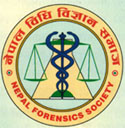NEPAL FORENSIC SOCIETY
Registered under the Nepal Law, Reg.No.622/053-54
|
|
JUSTICE BY FORENSIC SCIENCE
|
Source: A.
Midori Albert, Ph.D. What is Anthropology and Forensic Anthropology ? Anthropology is the "study of humans" in a broad sense. There are primarily three subfields of anthropology, or three general areas into which the study of humans can be classified: Cultural anthropology, Archaeology, and Physical (or Biological) Anthropology. A fourth subfield, Linguistics (pertaining to language), seems to have been absorbed by the other three subfields in many cases today. Cultural Anthropology Cultural Anthropology: this subfield deals with myriad aspects of human society, culture, behavior, beliefs, ways of life, etc. It can include studies of non-technologic societies, technologic societies, past and present. There is often much overlap with other disciplines in anthropology. For example, cultural anthropology may overlap with studies of foreign language, economics, psychology, sociology, political science, the medical field, ecology, women's studies, history, and so on. Archaeology Archaeology is the study of past cultures, through peoples' material remains (i.e. artifacts). The lifeways of past peoples can be studied from the artifacts they leave behind, which can range from items as small as bits of pottery and tools to large dwellings--huts, houses of worship, etc. Archaeological research covers a vast array of cultures throughout time and space--from prehistory on up to our recent past, all over the world. Other disciplines that are often integrated with archaeology include: geology, geography, ecology, history, etc. Physical or Biological Anthropology Physical (aka Biological) anthropology deals with the physical and biological aspects of the primate order: humans, chimps, gorillas, monkeys, prosimians, etc., past and present. Thus, some of the more specialized areas covered under this large subfield of anthropology include: primate biology and behavior, osteology (the study of bones), paleoanthropology (the study of old dead primates--human and non-human), skeletal biology, human variation and adaptation (which explores how various groups of humans adapted over time to different climates, altitudes, environmental conditions, etc. providing us with the diversity we see today), human growth and development, nutrition, genetics, etc. So, what exactly is Forensic Anthropology? Well, from within the specialized area of osteology--the study of bones--comes the application of the methods and techniques of analyzing skeletal remains to cases of legal importance. Osteological analyses yield clues as to how populations of people might have lived, how old they were when they died, if they were female or male, their state of health (or disease), types of trauma they may have experienced as related to climate, warfare, or occupation. When we apply methods of studying the skeleton to cases of unknown modern remains, we are using osteology in a legal context; therefore we are practicing forensic anthropology (forensic means legal). Forensic anthropologists help identify individuals who died in mass disasters, wars, or due to homicide, suicide, or accidental death.
|
|
|

